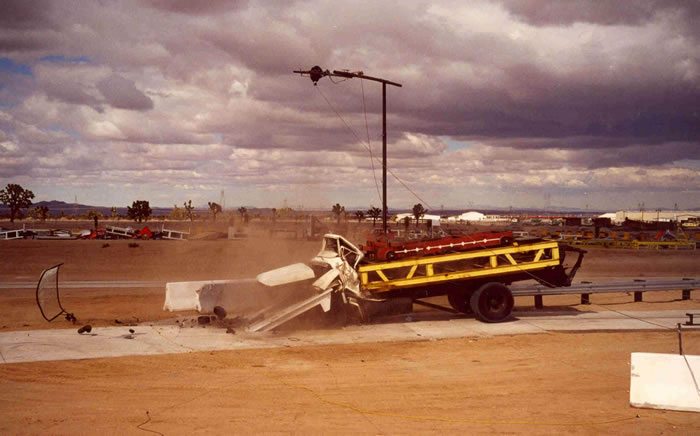Back in 1985, the U.S. Department of State’s Bureau of Diplomatic Security published the original vehicle test barrier methods – SD-STD-02.01 – to assess the crash performance of perimeter barriers and gates. Since then, from the initial World Trade Center bombing to 9/11 and beyond, the rise in vehicle bombings has increased dramatically. As a result, the Bureau addressed the need to address a broader spectrum of conditions, including vehicle types, attack velocities and acceptable penetration distances.
Originally, in order to be certified by the DOS, vehicle barriers must face Vehicle Crash Testing by an independent crash test facility. Certification is based on speed and penetration ratings. “K” has indicated vehicle speed during the crash test; and “L” indicated the maximum allowed penetration of the barrier by the vehicle.
For test purposes, K12 denoted a speed of up to 50 mph, and L3 (the highest penetration rating) denoted a penetration of three feet or less. Other ratings included: K8 = 40 mph; K4 = 30 mph; L2 = 3 ft. to 20 ft.; and L1 = 20 ft. to 50 ft. Penetration levels were set at 3 feet (1 m), 20 feet (6 m) and 50 feet (15 m), measured from the point of attack to the final resting place.
In 2005, a revision (rev A) issued an update, eliminating all penetration levels except the 3 feet (1 m) standard. Since it was determined that the cargo beds often went beyond the front of the vehicle in a crash, the Bureau also updated the way the test was to be conducted. They specified what the payload should be, 55 gallon steel drums filled with soil and strapped together, and how to measure the penetration, distance from the inside of the barrier to the front of the cargo bed.
Importantly, it was recognized that different types of trucks use different platforms, which would affect results. So, the new DOS test standard required the use of pick-ups, medium sized trucks and trucks that haul heavy goods. As a result, today’s buyer of anti-terrorist barriers, bollards, gates and barricades is able to select the device most appropriate for their facility with a defined vehicle threat.
First – A Quick Lesson in Physics to Help Understand
During Vehicle Crash Testing a vehicle moving towards a barricade has a certain kinetic energy, which is the major measure of how much “hitting power” it possesses. Mathematically, kinetic energy is derived from the vehicle velocity acceleration and its mass. On impact, some of this energy is converted to heat, sound and permanent deformation of the vehicle. The barricade must absorb the remainder of this energy if the vehicle is to be stopped.
The amount of remaining energy varies depending on many factors, primarily the velocity of the vehicle at the moment of impact. The amount of kinetic energy posed by a vehicle changes as the square of its velocity. For example, a vehicle moving at 50 mph has 25 times as much kinetic energy as it would at 10 mph. Thus, an armored car weighing 30 times as much as a Toyota Corolla and moving at 10 mph would have less hitting power than the Toyota moving at 60 mph!
Because of the relationship of velocity to the total kinetic energy possessed by the vehicle, every effort must be made by the security engineer to force a vehicle to slow down before it reaches the barricade. The most frequently used technique is to require a sharp turn immediately in front of the barrier. When vehicle speed is reduced by 50 percent, the “hitting power” is reduced by four times. If the speed is reduced by 2/3rds, the force of impact will be reduced by nine times.
Use These Standards for Impact Condition Designations
Four types of vehicles are defined:
1. Small Passenger Car: The car must have been manufactured in the last 10 years and weigh 2430 +/- 50 pounds (1100 +/- 22 kg).
2. Pickup Truck: The truck must be a ¾-ton model, manufactured within the last 10 years and weigh 5070 +/- 100 pounds (2300 +/-46 kg).
3. Medium Duty Truck: This vehicle must have a diesel engine with a vehicle mass of 15,000 +/- 300 pounds (6800 +/- 136 kg).
4. Heavy Goods Vehicle: This must be a tandem axle dump truck or tandem axle with drop axle truck, tested at 65,000 +/- 1300 pounds (29,500 +/- 590 kg).
While defining the types of vehicles, the Bureau also established new penetration ratings:
· P1 Less than or equal to 3.3 feet (1 m)
· P2 3.31 to 23.0 feet (1.01 to 7 m)
· P3 23.1 to 98.4 feet (7.01 to 30 m)
· P4 98 feet + (30 m +)
The accompanying chart, “Impact Condition Designations,” puts everything together.
Note some of the differences. Most importantly, the new designations actually make some sense in that a car designation starts with a “C”, the pick-up is designated as a “P”, the medium duty truck gets an “M” and the heavy goods vehicle is labeled an “H”. The number following the letter is the speed, measured in mph. Thus, a “40” means the vehicle was tested at 38.0 to 46.9 mph. An H30 designation thus defines a heavy goods vehicle traveling at approximately 30 mph.
As a result, it is quite easy to determine the condition designation:
Car C40, C50 and C60
Pick-up P40, P50 and P60
Medium duty truck M30, M40 and M50
Heavy goods H30, H40 and H50
What Is the Difference?
It’s easiest to show the difference in designations with an example. For instance, the Delta DSC501 is presently rated as a K54-certified barrier. That means it has been tested to stop a 65,000-pound truck traveling at 50 mph dead in its tracks during Vehicle Crash Testing. That also means it took on 5.4 million foot-pounds. Under the new system, the DSC501 would be designated as an H50.

